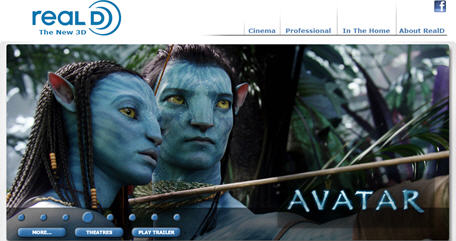RealD plots IPO: Can it replicate the Avatar pop?

RealD, a leading provider of 3D technology to movie theaters and potentially consumers, outlined a bevy of growth opportunities (and risks) in its regulatory filing that jump out at you. But the biggest question is whether RealD's Avatar-fueled growth rates can be replicated in the years ahead.
First, the details. RealD has its technology deployed on 5,321 theater screens in 51 countries. That tally puts it in front of the 3D pack and it has wide distribution with theater chains such as AMD, Cinemark and Regal. RealD said there are plans to add its technology to an additional 4,900 screens.
Meanwhile, RealD supplied the glasses and projectors to show the film Avatar, which was a runaway hit.
Toss in the potential of consumer adoption of 3D technology in the home and RealD could have some mojo. RealD said in its filing:
Since the release of Chicken Little in 2005 through the end of 2009, 27 3D motion pictures have been released. We anticipate that 21 3D motion pictures will be released worldwide during 2010, including sequels to successful major motion picture franchises such as Harry Potter, Shrek and Toy Story. As the number of RealD-enabled screens and 3D motion pictures released increases, we expect that our revenue will continue to grow.
We believe that the recent success of major 3D motion pictures, including Avatar and Alice in Wonderland, is leading to the creation and distribution of new 3D content for the consumer electronics market. The development of this market represents a significant opportunity for new revenue arising from improved 3D technologies, the release of 3D-enabled consumer electronics products and the increased availability of 3D content for the home and elsewhere.
There are the financials to consider. For the year ended March 27, 2009, RealD reported net revenue of $39.67 million, up from $23.4 million in 2008. For 2009, the company had a net loss of $16.3 million, a bit better than the $17.9 million in lost in 2008.
And then came Avatar. For the nine months ending, December 25, 2009, the company lost $20.3 million on revenue of $95.9 million.
In other words, there's real growth there, but can that Avatar boost be sustained? Will RealD be like a baseball player that comes off the steroids and can't hit the home runs anymore?
Among the more interesting items in RealD's initial prospectus:
- It's unclear whether 3D in consumer electronics will be a hit. RealD said it has deals with JVC, Panasonic, Samsung, Sony Electronics and Toshiba to enable 3D viewing television, laptops and other displays, but it's unclear how the market will develop.
- RealD licenses its technology for use in Christie projectors, Doremi servers, Harkness Hall screens and the Sony Electronics 4K SXRD digital cinema projectors.
- Competition is fierce. RealD cited Dolby, IMAX, MasterImage 3D and X6D Limited as primary rivals.
- The Food and Drug Administration could regulate 3D glasses. The company said:
Currently, polarized eyewear, including our RealD eyewear, is not regulated by the FDA, or by state or foreign agencies. However, certain eyewear, such as non-prescription reading glasses and sunglasses, are considered to be medical devices by the FDA and are subject to regulations imposed by the FDA and various state and foreign agencies. With the rising popularity of polarized 3D eyewear, there has been an increasing level of public scrutiny examining its potential health risks. Polarized 3D eyewear, including our RealD eyewear, may at some point be subject to federal, state or foreign regulations that could potentially restrict how our RealD eyewear is produced, used or marketed, and the cost of complying with those regulations may adversely affect our profitability.
- And speaking of those health risks. The company said:
Research conducted by institutions unrelated to us has suggested that 3D viewing with active or passive eyewear may cause vision fatigue, headaches, motion sickness or other health risks. If these potential health risks are substantiated or consumers believe in their validity, demand for the 3D viewing experience in the theater, the home and elsewhere may decline. As a result, major motion picture studios and other content producers and distributors may refrain from developing 3D content, motion picture exhibitors may reduce the number of 3D-enabled screens (including RealD-enabled screens) they currently deploy or plan to deploy, or they may reduce the number of 3D motion pictures exhibited in their theaters, which would adversely affect our results of operations, financial condition and prospects. A decline in consumer demand may also lead consumer electronics manufacturers and content distributors to reduce or abandon the production of 3D products, which could adversely affect our prospects.
In addition, if health risks associated with our RealD eyewear materialize, we may become subject to governmental regulation or product liability claims, including claims for personal injury.
